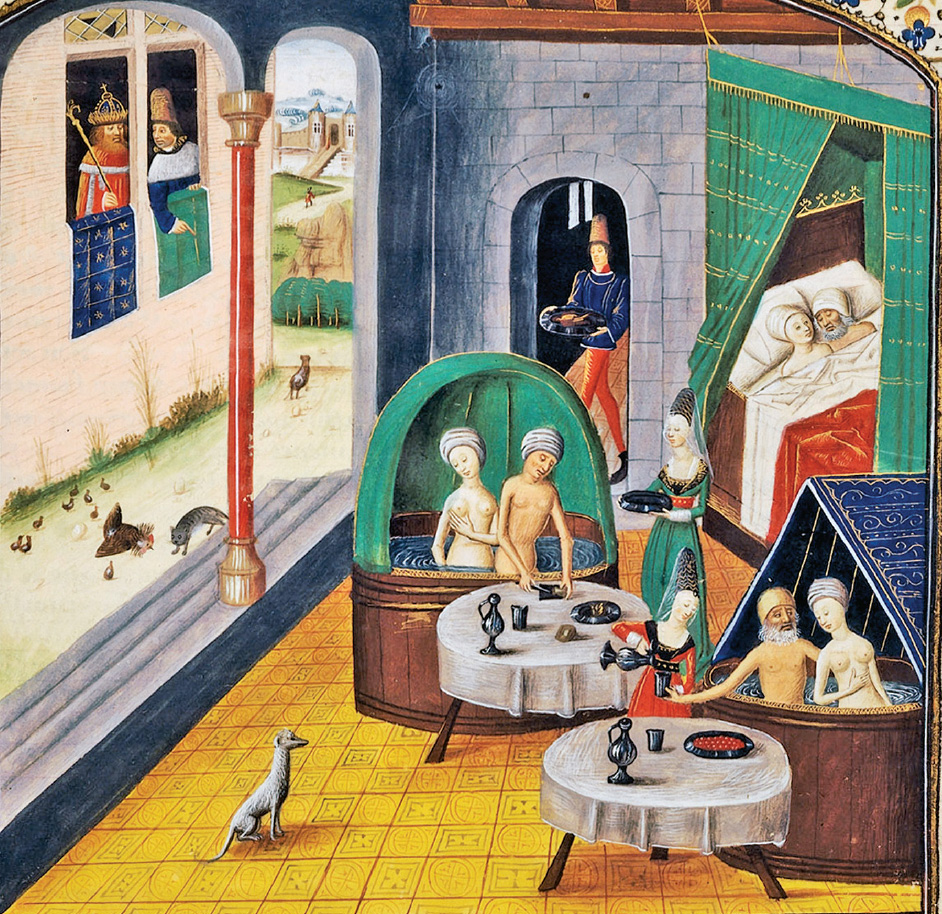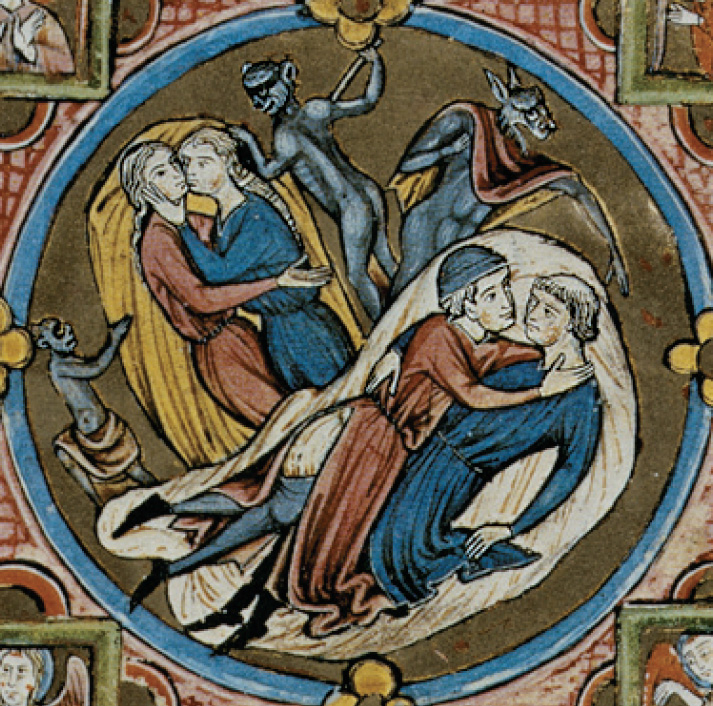Sex in the City
Peasant and urban revolts and riots had clear economic bases, but some historians have suggested that late medieval marital patterns may have also played a role. In northwestern Europe, people believed that couples should be economically independent before they married. Thus not only during times of crisis such as the Great Famine, but also in more general circumstances, men and women spent long periods as servants or workers in other households, saving money for married life and learning skills, or they waited until their own parents had died and the family property was distributed.
The most unusual feature of this pattern was the late age of marriage for women. Unlike in earlier time periods and in most other parts of the world, a woman in late medieval northern and western Europe generally entered marriage as an adult in her twenties and took charge of running a household immediately. She was thus not as dependent on her husband or mother-in-law as was a woman who married at a younger age. She also had fewer pregnancies than a woman who married earlier, though not necessarily fewer surviving children.
Men of all social groups had long tended to be older than women when they married. In general, men were in their middle or late twenties at first marriage, with wealthier urban merchants often much older. Journeymen and apprentices were often explicitly prohibited from marrying, as were the students at universities, who were understood to be in “minor orders” and thus like clergy, even if they were not intending to have careers in the church.
The prohibitions on marriage for certain groups of men and the late age of marriage for most men meant that cities and villages were filled with large numbers of young adult men with no family responsibilities who often formed the core of riots and unrest. Not surprisingly, this situation also contributed to a steady market for sexual services outside of marriage, services that in later centuries were termed prostitution. Research on the southern French province of Languedoc in the fourteenth and fifteenth centuries has revealed the establishment of legal houses of prostitution in many cities. Municipal authorities set up houses or districts for prostitution either outside the city walls or away from respectable neighborhoods. For example, authorities in Montpellier set aside Hot Street for prostitution, required women who sold sex to live there, and forbade anyone to molest them. Prostitution thus passed from being a private concern to a social matter requiring public supervision. The towns of Languedoc were not unique. Public authorities in Amiens, Dijon, Paris, Venice, Genoa, London, Florence, Rome, most of the larger German towns, and the English port of Sandwich set up brothels.
Young men associated visiting brothels with achieving manhood; for the women themselves, of course, their activities were work. Some women had no choice, for they had been traded to the brothel manager by their parents or some other person as payment for debt, or had quickly become indebted to the manager (most of whom were men) for the clothes and other finery regarded as essential to their occupation. The small amount they received from their customers did not equal what they had to pay for their upkeep in a brothel. Poor women — and men — also sold sex illegally outside of city brothels, combining this with other sorts of part-time work such as laundering or sewing. Prostitution was an urban phenomenon because only populous towns had large numbers of unmarried young men, communities of transient merchants, and a culture accustomed to a cash exchange.

Though selling sex for money was legal in the Middle Ages, the position of women who did so was always marginal. In the late fifteenth century cities began to limit brothel residents’ freedom of movement and choice of clothing, requiring them to wear distinctive head coverings or bands on their clothing so that they would not be mistaken for “honorable” women. Cities also began to impose harsher penalties on women who did not live in the designated house or section of town. A few women who sold sex did earn enough to donate money to charity or buy property, but most were very poor.
Along with buying sex, young men also took it by force. Unmarried women often found it difficult to avoid sexual contact. Many worked as domestic servants, where their employers or employers’ sons or male relatives could easily coerce them, or they worked in proximity to men. Notions of female honor kept upper-class women secluded in their homes, particularly in southern and eastern Europe, but there was little attempt anywhere to protect female servants or day laborers from the risk of seduction or rape. Rape was a capital crime in many parts of Europe, but the actual sentences handed out were more likely to be fines and brief imprisonment, with the severity of the sentence dependent on the social status of the victim and the perpetrator.
According to laws regarding rape in most parts of Europe, the victim had to prove that she had cried out and had attempted to repel the attacker, and she had to bring the charge within a short period of time after the attack had happened. Women bringing rape charges were often more interested in getting their own honorable reputations back than in punishing the perpetrators. For this reason, they sometimes asked the judge to force their rapists to marry them.

Same-sex relations — what in the late nineteenth century would be termed “homosexuality” — were another feature of medieval urban life (and of village life, though there are very few sources relating to sexual relations of any type in the rural context). Same-sex relations were of relatively little concern to church or state authorities in the early Middle Ages, but this attitude changed beginning in the late twelfth century. By 1300 most areas had defined such actions as “crimes against nature,” with authorities seeing them as particularly reprehensible because they thought they did not occur anywhere else in creation. Same-sex relations, usually termed “sodomy,” became a capital crime in most of Europe, with adult offenders threatened with execution by fire. The Italian cities of Venice, Florence, and Lucca created special courts to deal with sodomy, which saw thousands of investigations.
How prevalent were same-sex relations? This is difficult to answer, even in modern society, but the city of Florence provides a provocative case study. In 1432 Florence set up a special board of adult men, the Office of the Night, to “root out … the abominable vice of sodomy.”9 Between 1432 and the abolition of the board in 1502, about seventeen thousand men came to its attention, which, even over a seventy-year period, represents a great number in a population of about forty thousand. The men came from all classes of society, but almost all cases involved an adult man and an adolescent boy; they ranged from sex exchanged for money or gifts to long-term affectionate relationships. Florentines believed in a generational model in which different roles were appropriate to different stages in life. In a socially and sexually hierarchical world, the boy in the passive role was identified as subordinate, dependent, and mercenary, words usually applied to women. Florentines, however, never described the dominant partner in feminine terms, for he had not compromised his masculine identity or violated a gender ideal; in fact, the adult partner might be married or have female sexual partners as well as male. Only if an adult male assumed the passive role was his masculinity jeopardized.
Thus in Florence, and no doubt elsewhere in Europe, sodomy was not a marginal practice, which may account for the fact that, despite harsh laws and special courts, actual executions for sodomy were rare. Same-sex relations often developed within the context of all-male environments, such as the army, the craft shop, and the artistic workshop, and were part of the collective male experience. Homoerotic relationships played important roles in defining stages of life, expressing distinctions of status, and shaping masculine gender identity. Same-sex relations involving women almost never came to the attention of legal authorities, so it is difficult to find out how common they were. However, female-female desire was expressed in songs, plays, and stories, as was male-male desire, offering evidence of the way people understood same-sex relations.